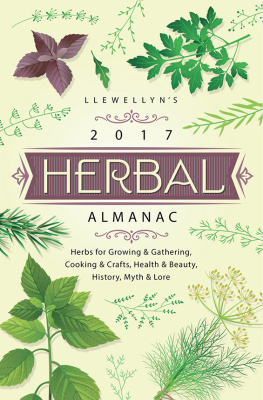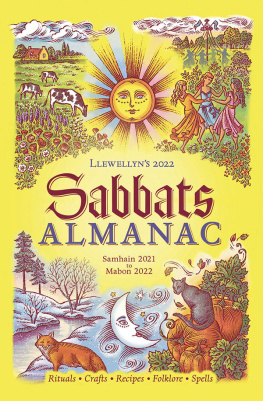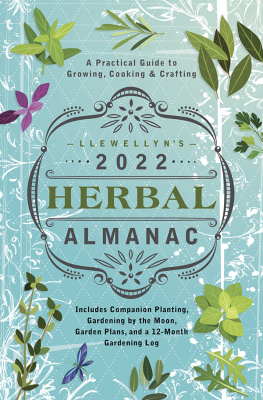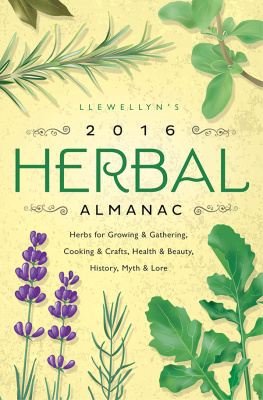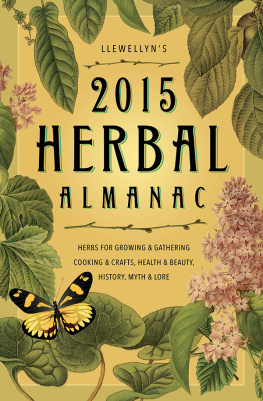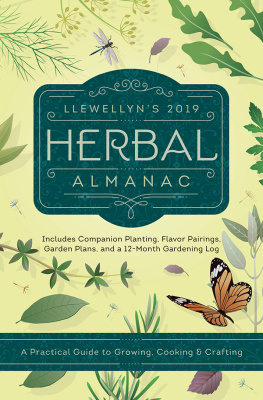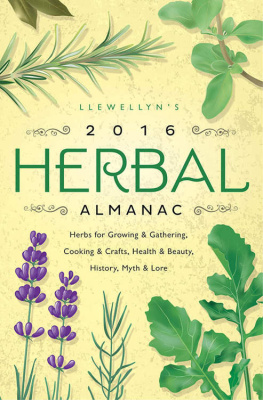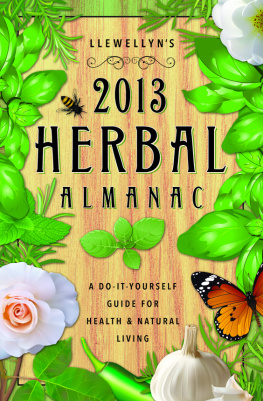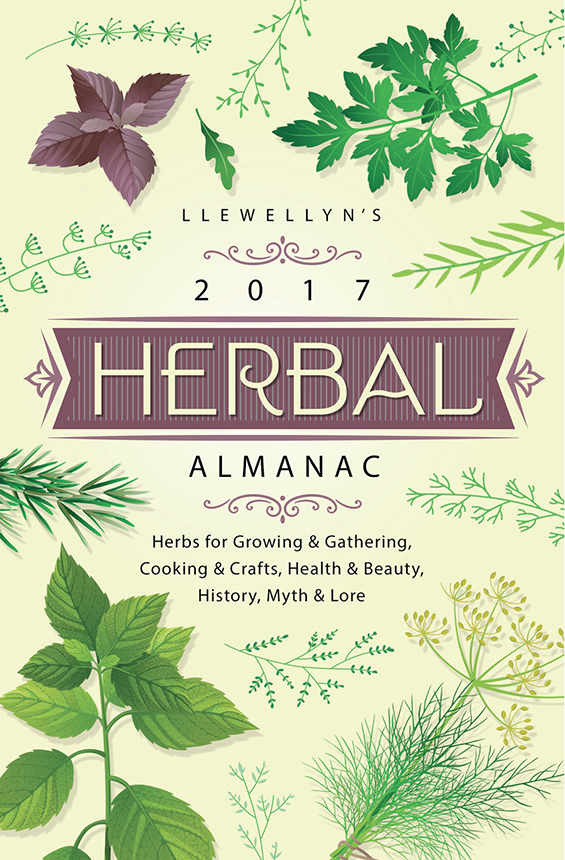
2016 Llewellyn Publications is a registered trademark of Llewellyn Worldwide Ltd.
Cover Design: Kevin R. Brown
Editing: Ed Day and Lauryn Heineman
Cover images:
iStockphoto.com/22814004, 22918495/ mart_m
iStockphoto.com/36660630/ mooozi
iStockphoto.com/23933332/ edge69
Interior Art: Fiona King
You can order annuals and books from
New Worlds, Llewellyns catalog. To request
a free copy, call 1-877-NEW WRLD toll-free
or visit www.llewellyn.com.
ISBN 978-0-7387-3761-4
Llewellyn Worldwide Ltd.
2143 Wooddale Drive
Woodbury, MN 55125-2989
Printed in the United States of America
Contents
to Llewellyns Herbal Almanac
by Natalie Zaman
by Jill Henderson
by Charlie Rainbow Wolf
by Estha K. V. McNevin
by Melanie Marquis
by James Kambos
by Jill Henderson
by Lupa
by Susan Pesznecker
by Doreen Shababy
by Alice DeVille
by JD Hortwort
by Anne Sala
by Magenta Griffith
by Dallas Jennifer Cobb
by Sally Cragin
by Deborah Castellano
by Susan Pesznecker
by Lupa
by Diana Rajchel
by Suzanne Ress
by Linda Raedisch
by Autumn Damiana
by Natalie Zaman
by Monica Crosson
by Thea Fiore-Bloom
by Tiffany Lazic
by Suzanne Ress
by Elizabeth Barrette
by Diana Rajchel
by Doreen Shababy
JanuaryDecember
Introduction to
Llewellyns Herbal Almanac
M ore and more people are using herbs, growing and gathe ring them, and studying them for their enlivening and healing properties. Whether in the form of plant therapy, a dye garden, or a new favorite recipe, herbs can clearly enhance your life.
In the 2017 edition of the Herbal Almanac , we once again feature some of the most innovative and original thinkers and writers on herbs. We tap into the practical, historical, and enjoyable aspects of herbal knowledgeusing herbs to help you reconnect with the earth, enhance your culinary creations, and heal your body and mind. The thirty-one articles in this almanac will teach you everything from growing a square-foot garden to the etymology of the herbs you might plant there. Youll also learn how to create cosmetics from natural ingredients, to grow a garden thats beneficial to bees, and to craft cordials and liqueurs. Enjoy!
Note: The old-fashioned remedies in this book are historical references used for teaching purposes only. The recipes are not for commercial use or profit. The contents are not meant to diagnose, treat, prescribe, or substitute consultation with a licensed health-care professional. Herbs, whether used internally or externally, should be introduced in small amounts to allow the body to adjust and to detect possible allergies. Please consult a standard reference source or an expert herbalist to learn more about the possible effects of certain herbs. You must take care not to replace regular medical treatment with the use of herbs. Herbal treatment is intended primarily to complement modern health care. Always seek professional help if you suffer from illness. Also, take care to read all warning labels before taking any herbs or starting on an extended herbal regimen. Always consult medical and herbal professionals before beginning any sort of medical treatmentthis is particularly true for pregnant women. Herbs are powerful things; be sure you are using that power to achieve balance.
Llewellyn Worldwide does not participate in, endorse, or have any authority or responsibility concerning private business transactions between its authors and the public.
Growing
and
Gathering Herbs
Unraveling the Tapestry of the Medieval Garden
by Natalie Zaman
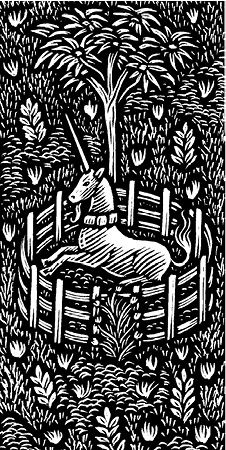
C an you find the frog? Hes hidden in the flowers and easy to miss. Most folks who visit the Unicorn Tapestry room in the Cloisters museum and gardens in New York and gaze at The Unicorn in Captivity have their eyes on the unicorn. He sits in a garden under a pomegranate tree, the juice from the overripe fruit dripping down his back. The surrounding landscape is lush and filled with a thousand flowers ( millefleur) as well as a few insects and, of course, the frog. Each of the seven tapestries is ripe with symbolism (as was much of the medieval world). But look closely at the scenes before you: amid the hidden references is a picture of life in the Middle Ages, much of which was centered around gardening.
The garden plots of the Middle Ages were places where practicality, pleasure, superstition, science, and spirituality all existed comfortably side by side. Plants that fed and healed the body also brought comfort to the soul through religious symbolism or protectionreal and imaginedthrough old wives tales and folklore. Elements such as fishponds, dovecotes, and beehives were incorporated into their schemes for their produce as well as sufficiency; fishponds were water sources, the denizens of dovecotes provided fertilizer as well as feathers for pillows and bedding, and bees were a means of pollination.
The Middle Ages encompassed the period from about 500 to 1400 CEthats nine hundred years of horticultural evolution. According to Marilyn Stokstad and Jerry Stannard, curators of the Gardens of the Middle Ages exhibit at the Spencer Museum of Art in Lawrence, Kansas, and Dumbarton Oaks in Washington, DC, five types of gardens could be found in medieval Europe: the cloistered gardens of religious orders; the kitchen gardens tended by all households, large and small; herbariums , devoted to medicinal and other practical herbs; and the patrician and pleasure gardens of the upper classes. Each one has its own unique wisdom to share with us.
The Hortus Conclusus
Executed in the eleventh century, the plan for the cathedral, abbey, and gardens of the monastery of St. Gall in Switzerland (never fully completed) is the only large-scale architectural drawing to survive the Middle Ages. In addition to an herbarium and kitchen garden, a block of space just to the right of the cathedral was set aside for a hortus conclusus an enclosed contemplative garden.
For folks who followed the Christian faith, paradise was the ultimate garden from which man was expelled. In one sense the contemplative garden (sometimes called a cloister garden because it is surrounded by covered walkways or a wall of some kind) was an attempt to recapture paradise as a man-made heaven on earth.
Meant to be an expression of the divine order, the contemplative garden was a place of prayer, meditation, and solitude, and it was instantly recognizable because of its symmetry. Divided into quadrants by intersecting paths, this space was planted simply, sometimes just with patches of turf or lawn with trees for shade and benches to sit. Life sustaining and spiritually cleansing, a water source sat at its center in the form of a fountain or wellhead, at the foot of which at least three symbolic (and fragrant) flowers could usually be found.
A rosary was literally a rose garden, but in the thirteenth century the word evolved to mean the garden of prayers devoted to the Virgin Mary, whose array of floral symbols included the rose. The Venerable Bede, medieval historian, linked the lily to Mary: the white petals symbolized the purity of her body, the golden center was the light of her soul, and its heavenly scent represented her divinity. Low to the ground, the violet can survive in a variety of climates. It has a lovely fragrance, though not a showy blossom. These humble traits earned it a place as yet another symbol of Mary, whose humility and gentle power were a comfort and inspiration to humankind.

